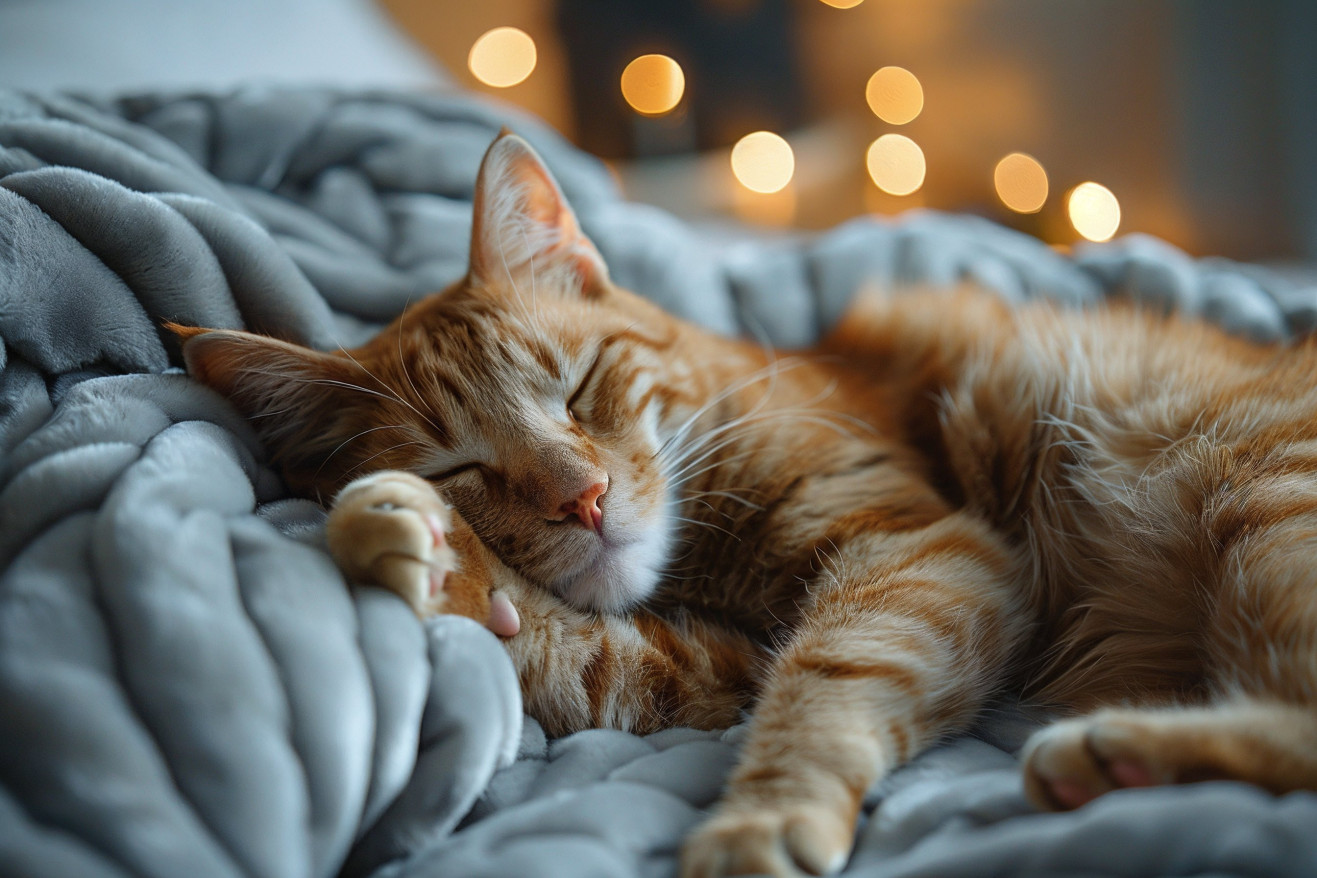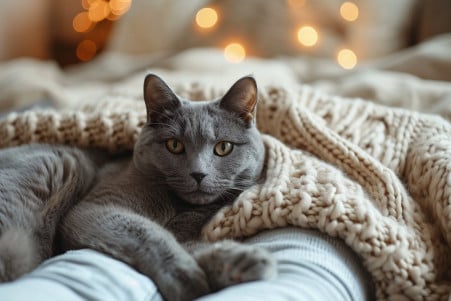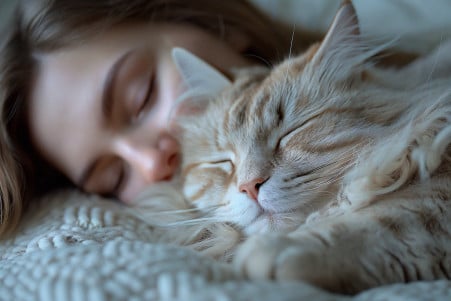Why Do Cats Cover Their Faces When They Sleep? Understanding Feline Sleep Habits
6 March 2024 • Updated 4 March 2024

This article answers the age-old question of why cats cover their faces when they sleep. Cats cover their faces when sleeping for a variety of reasons, including security and comfort, to block out light, and to keep their noses warm. This behavior, which can be traced to cats’ survival instincts, enables them to conserve energy and feel safe in their surroundings while they sleep.
This article will take a deep dive into the world of animal behavior, drawing on research from veterinary science, zoology, and animal psychology. Topics covered will include studies on feline sleep, senses, and the environment, as well as evolutionary factors that may have contributed to this cute behavior. Through this research, you’ll learn everything you need to know about why your cat may cover its face while sleeping.
Why do cats cover their faces when they sleep?
Understanding the Senses of Sleeping Cats
Cats’ senses play a large role in their sleep habits, and their need to protect these senses may be the reason for their face-covering behavior.
PAWS Chicago says that a cat’s sense of smell is so strong that it can help them identify familiar places, which is important for feeling safe enough to sleep. It could be that cats cover their faces because their sense of smell is so strong that they want to shield themselves from any smells that could disrupt their rest.
Whiskers, or vibrissae, are also important in a cat’s sleep. Cats can sense even the smallest changes in their environment because their whiskers are so deeply rooted and connected to their nervous system. McGehee Clinic for Animals says that whiskers are used for navigation and as an emotional barometer, and this could be why cats like to cover their faces when they sleep.
In addition, a cat’s sense of touch is important in their sleep habits. When they cover their faces, they may be stimulating the many nerve endings in their fur, which can lead to a relaxing response. This is important because touch is a primary source of comfort from the time they are kittens.
A cat’s sense of hearing is also important, and their ears are designed to pick up even the smallest sounds. This behavior could also be a way to block out sounds that could be disturbing their rest.
In each of these cases, cats may be covering their faces when they sleep to satisfy these sensory needs—finding comfort, blocking out overwhelming stimuli, or engaging in self-soothing behavior. It’s a behavior that connects their natural inclinations with the need for a controlled sleeping environment, a subject that’s further explored in the environmental influences on feline sleep behavior.
Crafting the Purrfect Sleep Sanctuary: Environmental Considerations for Cat Napping
The environment in which a cat sleeps can profoundly influence its behavior, such as covering its face, which is rooted in the need for a controlled, comfortable resting space. Research from PMC highlights how a familiar and secure environment significantly affects cat welfare, emphasizing the impact of the macroenvironment—such as temperature, lighting, and noise—on their well-being.
Cats, highly sensitive to their surroundings, may cover their faces to mitigate unfavorable conditions, such as bright lights or loud sounds, thus creating a tranquil nook for slumber.
In the human household, both the macro and the microenvironment are important. WikiVet recommends that indoor environments be designed to meet the cat’s species-specific behavioral needs, including the need for privacy and choice, which can impact their sleep-wake cycle. A cat-friendly environment ensures that there is minimal disruption so that cats can achieve the sensory comfort they need during sleep, as noted by The Link Between the Environment and Cat Behavior.
Understanding the environmental factors that impact domestic cat care is important when it comes to understanding their sleep behavior. By creating an enriched environment that takes into account both macro and micro factors, owners can expect to see a happier, more relaxed cat that doesn’t feel the need to hide from the world.
This kind of cat care can lead to a stronger human-animal bond and can help cats feel more secure in their environment while also respecting the natural instincts that drive their behavior, including those they’ve inherited from their wild ancestors.
Unpacking the Evolutionary Roots of Cat Behavior
The long history of their wild ancestors may be why domestic cats bury their faces when they sleep. An article in Scientific American explains how the solitary lifestyle and survival strategies of wildcats have shaped the behavior of house cats.
The need for survival and protection during sleep— a time when cats are most vulnerable— led to behaviors that are still seen today. For example, the wild ancestors’ ability to be stealthy and their preference for secure, hidden places to sleep helped them conserve energy and stay safe from potential threats.
The article in Scientific American also cites research that suggests that the domestication process has preserved these instincts, tracing the lineage of the house cat back to the Middle Eastern wildcat, Felis silvestris lybica. This lineage has left a genetic imprint that has led to the domestic cat’s inclination to take similar protective measures when they sleep, including burying their faces.
While today’s cats are generations away from the dangers their ancestors faced, they still engage in these instinctual behaviors as evolutionary leftovers that make them feel safe. When they bury their faces, cats are not only harkening back to their ancestors’ need for concealment, but they are also responding to their surroundings and getting ready for the next phase of their day.
How Touch Affects Cat Napping
Cats’ sense of touch is a major factor in their unusual sleeping habits. Not only is touch a primary form of feline communication, but it also helps cats feel comfortable and secure.
This is especially true when cats are covering their faces while they sleep, as this behavior may be a result of the comfort they feel from the pressure and warmth of touch on their faces.
In fact, a study published in Scientific Reports found that cats have distinct touch preferences, which suggests that touch is a factor in their choice of sleeping position and whether or not they cover their faces.
The role of human touch in a cat’s sleep patterns is also important to consider. The way we pet and interact with our cats can affect their sense of security and, in turn, their ability to sleep in a vulnerable position.
The 2022 AAFP/ISFM Cat Friendly Veterinary Interaction Guidelines emphasize the importance of cat-friendly handling that respects cats’ preference for gentle touch. Pet parents who understand and respect these touch preferences can create an environment that supports their cats’ natural sleep patterns, which can help them get the restful, restorative sleep they need.
How to Help Your Cat Get Better Sleep
Improving your cat’s sleep environment can help them get better quality sleep. For example, PetMD suggests that because cats like to sleep in a curled-up position to conserve body heat, you should make sure your cat has a warm, comfortable bed in a quiet, draft-free area. Beds with raised edges can help your cat feel more secure and give them a place to rest their head.
In addition, make sure your cat’s bed is in a place where they won’t be disturbed by loud noises or bright lights. Cats are easily stressed by their environment, so a calm, quiet place to sleep will help them avoid disruptions to their sleep.
The Sleep Foundation explains that cats are crepuscular, meaning they are most active during the dawn and dusk hours, so you can help them get better sleep by making sure they have a calm place to rest during those times.
Meeting your cat’s sensory needs, like their need for warmth, can be as simple as providing a self-heating cat bed, especially if you live in a colder climate, according to Chewy. In addition, gently petting your cat before bed can help them feel safe and secure, and creating a routine can help them understand when it’s time to go to sleep.
Finally, make sure you’re paying attention to your cat’s individual needs. For example, if you notice that your cat is sleeping in a different place or in a different position, it could be a sign that they need a change in their sleep environment.
This is especially important as your cat gets older, when their sleep needs and preferences may change. By paying attention to your cat’s needs, you can make sure they have the best sleep environment possible, which will help them stay healthy and happy and help you maintain a strong bond with them.
Mystery Solved: Why Do Cats Cover Their Faces While Sleeping?
When cats are in the peaceful state of slumber, they often do something a bit strange: cover their faces. There are a few reasons why cats do this, and they all have to do with their biology and behavior.
In addition to providing comfort, covering their faces helps cats block out light so they can rest more deeply and save energy, which is especially important for these low-light hunters that are most active at dawn and dusk, according to BBC Science Focus. It also helps protect them by creating a safe space that meets their sensory and environmental needs.
All of these factors come together to explain why cats cover their faces when they sleep. Cats need to feel safe and secure, as Cats.com notes, and covering their faces in a tent-like manner helps them do that by allowing them to relax, protect their whiskers, and maintain a comfortable body temperature that’s conducive to rest.
So, the reasons why cats cover their faces when they sleep go beyond just an interesting quirk—it’s an important part of their welfare and well-being. It’s important for us to notice and understand these behaviors, which give us insight into our cats’ lives. As we learn more about cats, it’s important to continue to create an environment that supports and respects their natural behaviors.


